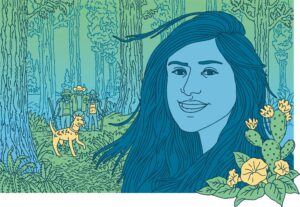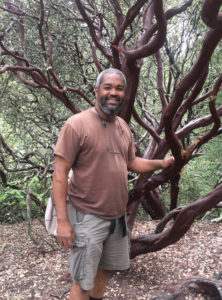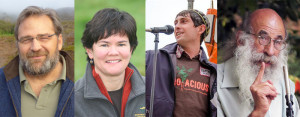It’s not easy to catch up with Cindy Moreno. The daughter of immigrant farmworkers from the Central Valley and a recent graduate in environmental studies from San Jose State, Cindy is doing more than her share for the environment. She works three days a week as an outreach specialist at WattzOn, a Silicon Valley start-up that develops online tools to help homeowners reduce their energy consumption. And two days a week she’s a garden-based educator at Full Circle Farm in Sunnyvale. And on weekends, she leads tours for the Guadalupe River Park Conservancy in San Jose. We caught up with her during a break at WattzOn.
BN: Where did you grow up?
CM: I grew up in Arvin, a small agricultural community about 15 miles from Bakersfield. It’s about 19,000 people, predominantly Latino. Almost all the people there speak Spanish, so it was an easy transition for my parents migrating over from Mexico when they were pretty young. I was born in the U.S., and so were my siblings.
BN: Did your parents work in the fields?
CM: They did. First they went through a variety of different crops. That’s kind of the way it works in the Central Valley; you go where the crops take you. But my dad apparently had a knack for grapes, and it was one of the more consistent jobs, so he stuck with that and eventually worked his way up to management. I’m really proud of him.
BN: And did you work in the fields too?
CM: When I was in high school, my parents encouraged me to go out and experience it. It was really hot – long hours, tough work; you had to get up really early and at the end of the day you just wanted to take a shower and go to sleep. I think they wanted us to experience it so we wouldn’t end up where they were, that we’d want to pursue higher education.
BN: What motivated you to leave home and go to San Jose State?
CM: In Arvin, a lot of people are very like-minded, and they just kind of get sucked into the community and stay there; they graduate from high school and then they start a family. I wanted to get out of that and see other opportunities. I chose San Jose State because I was going to do nursing and San Jose has a good nursing program. But I took an environmental studies class that was part of the general education requirement, and it really opened my eyes and I just got hooked.
What I really loved about environmental studies is that they do a lot of fieldwork. We did a lot of learning in the classroom, too, but it makes sense to go out into the field to see it for yourself, so for instance, in my restoration class, we visited a lot of restoration sites around the area. One of my favorites was Elkhorn Slough near Monterey.
BN: Tell us about your internship at the Don Edwards National Wildlife Refuge.
CM: During my senior year I was looking for part-time work and found the listing for a bilingual environmental education and outreach intern, so it sounded like something I could do. I was in charge of the visitor center, greeting guests, answering phones and visitors’ questions. For the other component, Latino outreach, I was trying to target the local community of Alviso by going to local libraries and doing bilingual workshops. Two programs that were really popular were about local owls. I would lecture about owls and then we would dissect these owl pellets I brought and get the kids to figure out what these owls had eaten; they really loved doing that.
I also created a program about wildlife careers, geared more for high school or college students. I got some people from Fish and Wildlife to talk about their experiences working there, the kind of work they did, and the kind of education they had. It was a really good program, great turnout. Those programs were bilingual, but I would gauge the crowd and see – sometimes do it mostly in Spanish, other times mostly in English with some Spanish mixed in.
BN: What’s your sense of how the Latino community in Alviso views the refuge?
CM: I think they view it in a positive light. The people in Alviso call the refuge “the Bird House” because they recognize that it’s a wildlife spot and that a lot of different birds migrate through there. And they do use the refuge. But it’s typically after hours. So at the end of the day, I would see them coming in on their bicycles or even walking, jogging, coming to enjoy the refuge, which made a lot of sense because they had to work during the day.
Part of my senior research project was on the hindrances to Alviso’s Latino families visiting the refuge. I conducted 100 surveys where I asked people what encouraged them to come to the refuge and what types of things might prevent them from visiting. Some of those barriers were lack of time and lack of transportation, but the language barrier was one of the biggest hindrances. A lot of the signs we have up to encourage people to learn more about the refuge are in English. You see a picture of a bird that has a little description, but if all of the information is in English, it’s not going to apply to you.
I think the refuge realizes that having Spanish-speaking staff is important, but they’re already really short-staffed. One of their goals is to incorporate more Spanish into their literature and their programs.
BN: You now work part-time at Full Circle Farm, even though you wanted to get away from agriculture.
CM: I had volunteered at Veggielution, an urban farm in San Jose where they teach you garden skills. And through them I got referred to Full Circle, where I was hired as a garden-based educator working mostly with sixth graders from Peterson Middle School, right behind the farm. The land is owned by the Santa Clara Unified School District and they lease it to us in return for free garden education for all the students. So the kids from Peterson get to walk right over and learn about being a farmer, to experience the whole life cycle of a plant, planting it as a seed, seeing it grow, harvesting it, then learning how to cook with these fresh ingredients, and then seeing it die, composting it and eventually seeing it become new life.
BN: So you work at Full Circle Farm and WattzOn, and you lead tours for the Guadalupe River Park Conservancy. What ties these all together?
CM: Some people might see these as really distinct, but they all tie together in that you’re learning to conserve the environment through different means. With energy, it’s important to teach people how to conserve energy at home, to encourage more energy-efficient habits. With agriculture it’s important to have local and sustainable food systems, because we have this huge disconnect with the community and where they get their food from – people don’t really know – and all the harmful chemicals that go into growing so much of our food. And then nature is obviously something that has taken a lot of punches, so it’s just teaching people that it’s important to preserve it for future generations, because if we degrade it now, there’s no way we’re going to get it back.





